“Water, water everywhere, Nor any a drop to drink”.
--The Rime of the Ancient Mariner
Clean water is a human need and a human right. Yet it’s becoming harder and harder to access. As
climate change worsens and populations increase, more regions are experiencing
water scarcity – even in developed countries.
The World Health Organization predicts that by 2025,
half the world’s population will be living in water-stressed areas. And by 2050, half the world’s population may no longer have
safe water.
Why is this happening when our planet is covered with water? For starters,
97 per cent of all water is salt water, contained within the oceans. Most of the world’s fresh water is locked up in glaciers and the polar ice caps. Only
0.3 per cent is above ground, in lakes and rivers, where people can reach it.
Today, the future of clean water has become a global concern. Already, at least
2 billion people globally are forced to drink from sources contaminated with faeces. Contaminated drinking water is estimated to cause 485 000 diarrhea-related deaths annually. Here in North America, population growth, climate change and costly water infrastructure upgrades are sending
home water bills skyrocketing.
In this article, you’ll learn how the world’s clean water situation is changing and why. You’ll discover what happens to people around the world who have no clean water close to home. And you’ll learn how you can help.
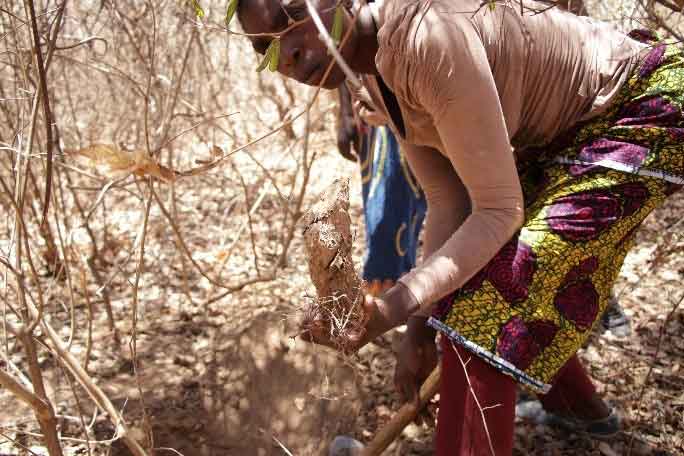 Zambia has been facing its worst drought in decades, says Josephine, showing a withered ear of corn. Clean water is hard to come by, leaving people parched and crops decimated. Photo: Tigana Chileshe
Zambia has been facing its worst drought in decades, says Josephine, showing a withered ear of corn. Clean water is hard to come by, leaving people parched and crops decimated. Photo: Tigana Chileshe
More people, different climate
Water doesn’t ever disappear from our planet and its atmosphere. But as the planet gets warmer, we humans can access less fresh water than before.
Precipitation patterns are changing meaning:
- less precipitation is falling as snow, leading to reduced runoff when the snow melts, to fill lakes, rivers and streams
- less rain is falling in many regions, meaning land becomes parched and lakes, rivers, streams and ponds dry up
- excess, unpredictable rainfall is causing floods in some areas, contaminating wells and boreholes
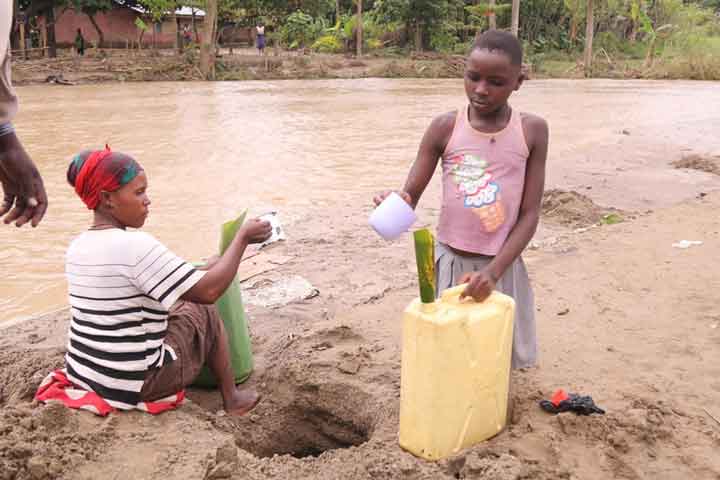 Floodwaters overcame this Ugandan village in 2019, contaminating water sources. The people feared outbreaks of cholera or other waterborne diseases. Photo: Joanitah Asiimire
Floodwaters overcame this Ugandan village in 2019, contaminating water sources. The people feared outbreaks of cholera or other waterborne diseases. Photo: Joanitah Asiimire
Climate change is reducing clean water access for billions of people. But other factors are also at play. We humans contribute directly to clean water scarcity.
- The world’s population has grown seven-fold in the past 200 years, to 7.8 billion people. Yet the amount of water available to us – including in the atmosphere and below the surface – has not increased.
- Irrigated agriculture represents 20 per cent of all cultivated land globally and contributes 40 per cent of the total food produced worldwide. Packaging goods and transporting them to market requires still more clean water.
- Industry builds economies and provides jobs. But its share of global water consumption is expected to rise to 38 per cent by 2040.
- Sharing water globally hasn’t been an option. Most nations seek to protect clean water sources within their boundaries, for the people who live there. And transporting water is expensive and energy consuming.
- Wealthier countries consume – and pollute – more than their fair share of water. The fashion industry alone plays a major role. It takes 2,700 litres of water to make one cotton shirt. That’s enough to meet an average person’s daily water drinking needs for more than two years.
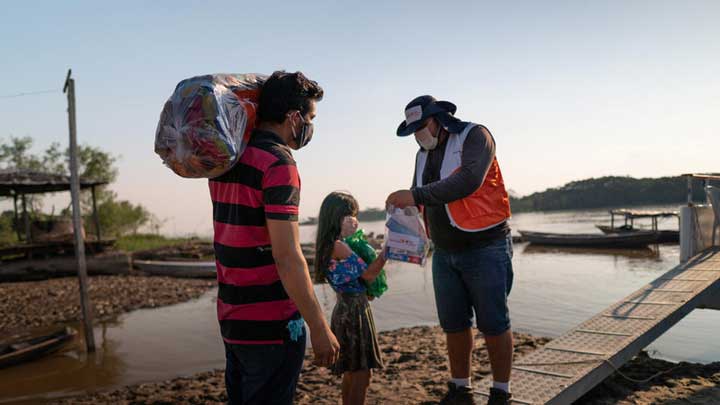 Though Brazil has the most freshwater in the world, it’s not distributed evenly within the country. Only 1.6 per cent is found in the most populous state, São Paulo. A full 70 per cent is found in the Amazon River. Photo: Álvaro Júnior
Though Brazil has the most freshwater in the world, it’s not distributed evenly within the country. Only 1.6 per cent is found in the most populous state, São Paulo. A full 70 per cent is found in the Amazon River. Photo: Álvaro Júnior
Clean water haves and have-nots
A report from the World Health Organization and UNICEF noted that
1.8 billion people have gained access to basic drinking water services since 2000. But clean water access is still unequal – even within countries.
- Fresh water is seldom equally distributed within the ‘have’ countries. Brazil, for example, has the greatest percentage of fresh water in the world. But most of it is found in the Amazon River – too far for most people to reach.
- ‘Fresh water’ and ‘clean water’ are not the same thing. Fresh water lakes and rivers can be badly polluted or contaminated. Here in Canada, lake water can have bacteria such as E. coli and contaminants from storm-water runoff.
- Infrastructure is needed to ensure access to safe, clean water and that’s not always evenly distributed. In many countries, for instance, wells and boreholes are few and far between, especially in rural areas.
- Wealthy countries also have water access challenges. The Council of Canadians notes, there are at least 100 drinking water advisories in effect at any given time within First Nations communities. The reasons include the lasting impact of colonization, with location and geology presenting additional challenges. As noted the National Post in December 2020:
“Heavy equipment can only get into some remote villages by ice roads that are only accessible for short periods. Other [villages] sit on beds of granite, which is incredibly costly to tunnel through. Many are in remote areas of the country where contractors are in short supply.”
When fresh water disappears altogether
You’ve likely heard the term ‘water scarcity’. It can mean two things:
- scarcity when governments fail to ensure a regular water supply i.e., they don’t provide enough infrastructure like boreholes and pipelines
- scarcity due to lack of physical shortage i.e., there simply isn’t enough water present – especially in arid regions
The world’s water use has been growing
at more than twice the rate of our overall population increase. More and more regions are reaching their limits for the delivery of sustainable water services. That’s especially true in arid regions.
Lake Chad example
Lake Chad used to be one of the world’s largest freshwater bodies. It was the primary water source for millions of people in Chad, Niger, Nigeria and Cameroon and provided livelihoods for some
30 million people.
But since the 1960s, Lake Chad has shrunk by
90 per cent, receding beyond the point of walking distance for families in four countries. The lake has dwindled from more than 25,000 square kilometres to just 1,500 square kilometres.
See before and after.
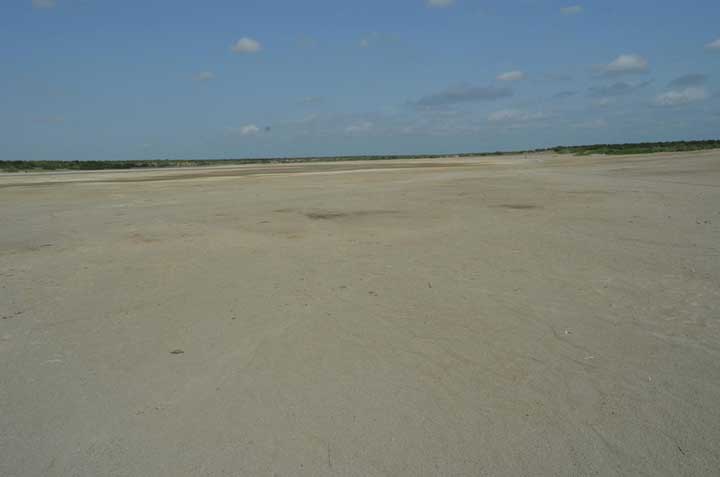 Lake Chad in West Africa used to be one of the world’s largest freshwater bodies. Photo: Michael Arunga
Lake Chad in West Africa used to be one of the world’s largest freshwater bodies. Photo: Michael Arunga
Lake Chad is a good example of why clean water is less accessible nowadays, especially in many low-income countries. Lake Chad disappeared due to a perfect storm of factors, including:
“Lake Chad is shrinking while the population is exploding,” says Muhammadu Buhari, president of Nigeria, who is leading a multi-billion-dollar effort to replenish the lake. He’s seeking to channel water from a river in the Democratic Republic of Congo, 2,400 km away.
Without clean water, people perish
For people without local access to clean water, life becomes exhausting, unhealthy, dangerous and limiting.
Women and girls bear the heaviest burden. Worldwide, girls and women spend a total of
200 million hours each day walking to collect water for their families. Their round-trip journeys average 6 kilometres per day.
Here’s what water scarcity can mean for people in the world’s poorest regions:
- Exhaustion – Young children, especially girls, struggle to carry heavy jerry cans long distances.
- Danger – Both the journey and the water source itself can be riddled with threats like poisonous snakes and wild animals. Small children left alone at home while mothers walk for water can be highly vulnerable.
- Sexual abuse – Girls and women walking long distances alone are especially vulnerable to assault along the way.
- Illness – Many water sources, like streams and ponds, are filled with harmful bacteria which make children sick, threatening their lives and futures. Illnesses can include diarrhea, cholera, dysentery, typhoid and polio.
- Blindness – Washing in dirty water can cause eye diseases like trachoma, which can lead to blindness if untreated.
- Lost education – Walking for water can take hours, causing children to miss school or feel too tired to do well.
- Lack of time for play – Play is critical for children as they make friends, cooperate to form teams, and develop leadership skills.
- Limited opportunities – When girls and women spend hours each day fetching water, it’s difficult to attend school (for girls) and harder to increase income or start a business (for women).
- Food insecurity – When rainfall is scant and there’s no water to irrigate, a family can lose their crop or garden.
- Poor nutrition – Families with meager income struggle to provide nutritious food for their children. Malnutrition is worsened by water-borne illnesses like diarrhea.
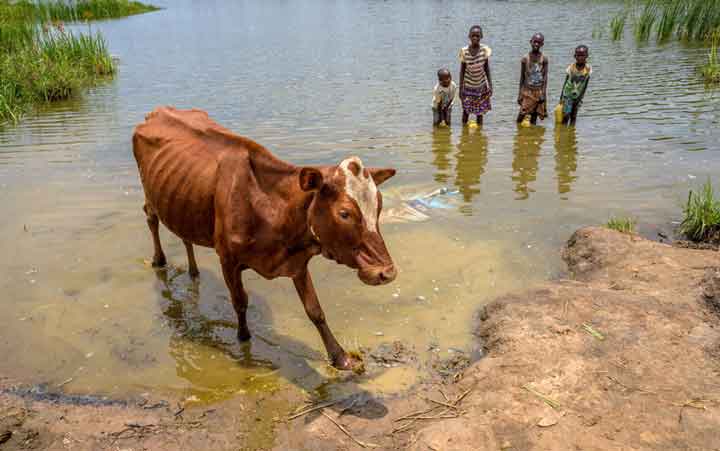 In Rwanda, the government’s pipeline infrastructure is insufficient for the population. Sandrine, Irene, Esther and Rebecca fill their jerry cans with putrid water from a polluted lake. Cattle defecate while drinking, making local children dangerously ill. Photo: Jon Warren
In Rwanda, the government’s pipeline infrastructure is insufficient for the population. Sandrine, Irene, Esther and Rebecca fill their jerry cans with putrid water from a polluted lake. Cattle defecate while drinking, making local children dangerously ill. Photo: Jon Warren
With clean water, everything changes
When people have clean water close to home, threats become opportunities. Slavery to water becomes freedom to use and enjoy water. Here are some examples:
- Clean water restores time and energy. When children aren’t walking long distances for water, they are freed for school and play.
- Clean water improves education. When children aren’t late because they’re fetching water, or missing school because they’re sick from waterborne illnesses, they have a better chance of learning well.
- Clean water grows opportunities. Women who no longer spend hours each day walking for water have more time to increase their income or start businesses.
- Clean water makes life safer. Without long walks through dangerous terrain, children don’t run the same risk of encountering threats like wild animals or abuse from adults along the way. Young children are no longer left at home alone while mothers collect water.
- Clean water keeps children healthier. Without waterborne illnesses like diarrhea to contend with, children aren’t at constant risk of sickness or death.
- Clean water makes for better nutrition. Without diarrhea and intestinal worms to drain nutrients from young bodies, children can better benefit from the foods they ingest.
 In Honduras, Gladys (right) and her friends enjoy drinking clean, clear water at school, and washing their hands. When children have potable water at school and home, they’re protected from illnesses wherever they go. Photo: Jon Warren
In Honduras, Gladys (right) and her friends enjoy drinking clean, clear water at school, and washing their hands. When children have potable water at school and home, they’re protected from illnesses wherever they go. Photo: Jon Warren
Clean water for everyone, everywhere
In 2010, the UN General Assembly explicitly recognized the
human right to water and sanitation. Every person on the planet has the right to sufficient, continuous, safe, physically accessible and affordable drinking water.
Organizations like World Vision work to improve clean water access in communities around the world. We do this through:
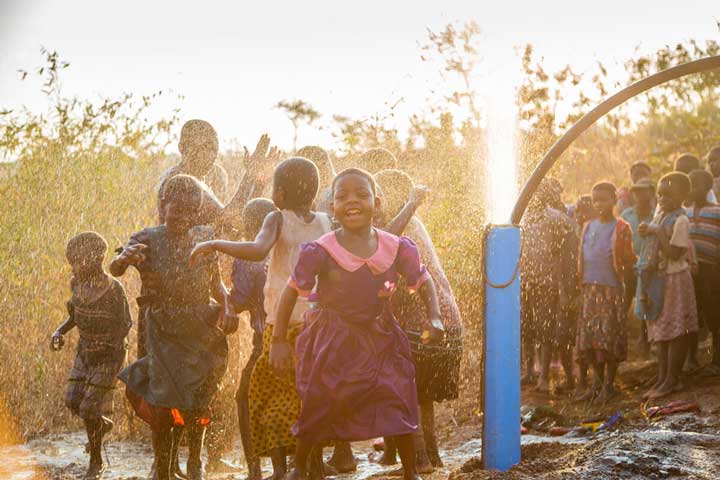 In Malawi, children celebrate in a spray of cold, clear water, after World Vision’s drill team hit groundwater. They will no longer have to walk 6 kilometres to collect unsafe water. Photo: World Vision
In Malawi, children celebrate in a spray of cold, clear water, after World Vision’s drill team hit groundwater. They will no longer have to walk 6 kilometres to collect unsafe water. Photo: World Vision
How you can help provide clean water
World Vision brings clean water to one new person every 10 seconds. Here are two ways you can help bring clean, safe water to children and families in need:
- The World Vision Gift Catalogue offers many ways to give the gift of water for people in need, in honour of a friend or family member.
- World Vision’s Global 6K for Water invites you to experience what millions of children do each day: walk, run or wheel an average of 6 kilometres for water. Try part of the distance carrying heavy water jugs. The funds you raise will support clean water programs overseas.
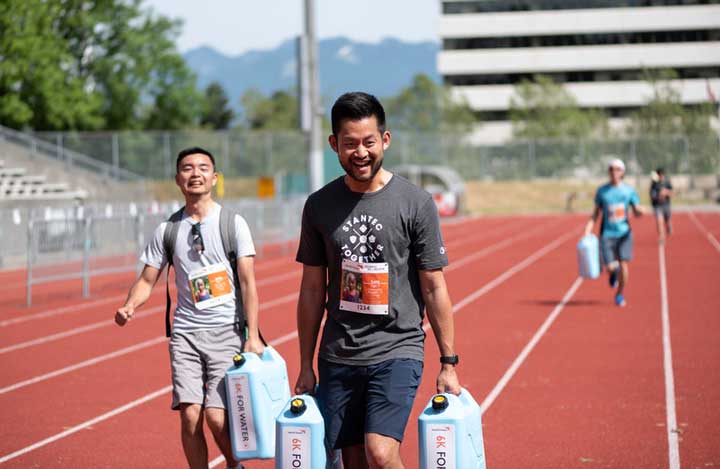 Participants race at the Global 6k for Water in Vancouver in 2019, to provide clean, life-changing water for children in the Democratic Republic of Congo. Photo: Daniel Mung
Participants race at the Global 6k for Water in Vancouver in 2019, to provide clean, life-changing water for children in the Democratic Republic of Congo. Photo: Daniel Mung
How the world is preparing for tomorrow
The World Health Organization predicts that by 2050,
half the world’s population may no longer have safe water.
Water scarcity has already led to armed conflict in some regions, making daily life even more dangerous.
The good news? Organizations from global to local are developing clean water strategies for the future. World Vision is amoung them. Here’s a glimpse:
World Vision’s clean water future
In line with
Sustainable Development Goal number six, World Vision's goal is that by 2030 all communities located within our development areas worldwide will have access to:
- clean water
- adequate sanitation
- hand-washing facilities
- menstrual hygiene facilities
- hygiene promotion and safe water learning
Why combine so many priorities – along with clean water? Because drinking water alone can’t keep children safe from threats like waterborne illnesses, lost education and physical and sexual assault.
- Children need safe latrines and handwashing stations to reduce the bacteria that cause illnesses like diarrhea, and to curb the spread of viruses like Ebola and COVID-19.
- Girls need safe menstrual hygiene facilities, both to guard their dignity and to keep them safe from sexual assault while using the washroom. This helps them thrive, learn and build brighter futures.
Wondering what kinds of water projects World Vision is developing today, that show promise for tomorrow? Here’s the type of innovation you may see more of in the future:
Gravity fed water pipeline systems
In the northern Kenyan community of Kesot, a hilltop dam protects and diverts spring water for the community.
- Water enters a pipeline which World Vision and community members helped build and maintain.
- Water travels to people’s homes and three primary schools below the hill.
- Schools are outfitted with tanks, hand-washing stations, and latrines for girls and boys of different genders and abilities.
This system will last well into the future because the community owns it. The water committee collects user fees to perform maintenance and operations.
 Kesot community members celebrate their new water system with songs, dances, and games in front of the water collection kiosk. Photo: Jon Warren
Solar-powered, reverse-osmosis water filtration
Kesot community members celebrate their new water system with songs, dances, and games in front of the water collection kiosk. Photo: Jon Warren
Solar-powered, reverse-osmosis water filtration
In Ab Kamari district, northwestern Afghanistan, World Vision and local leaders have devised an innovative, solar-powered, reverse-osmosis filtration system to bring clean water to residents.
- Water is pushed through the filter of a pressurized system, to remove harmful chemicals and bacteria.
- The system produces up to 4,300 litres of clean drinking water per hour and serves 700 households — about 4,900 people.